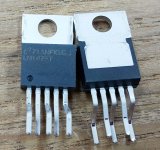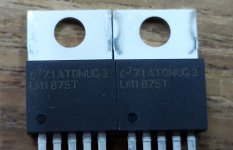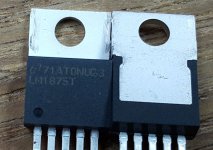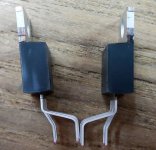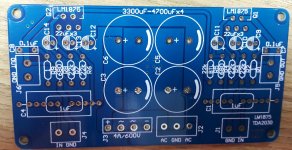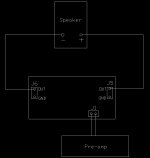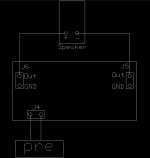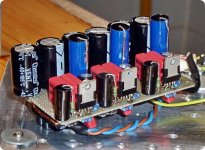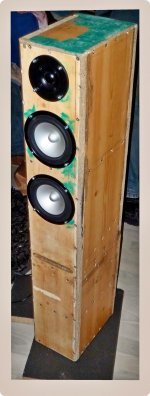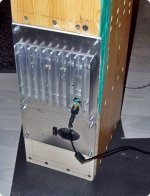BTL connection
Finally after assembly all the parts, it is working now. After burning in more than a week, now I wish to try the BTL mode. I have soldered the 22k BTL resistor (refer to picture attach). With usual connection I found out one side plays louder than another (The BTL printed side play louder). In BTL I should only hearing 1 side of sound, right?
By right, how do I connect it? Usual connection are 2 inputs and 2 outputs for speaker. Which one I should connect only?
Finally after assembly all the parts, it is working now. After burning in more than a week, now I wish to try the BTL mode. I have soldered the 22k BTL resistor (refer to picture attach). With usual connection I found out one side plays louder than another (The BTL printed side play louder). In BTL I should only hearing 1 side of sound, right?
By right, how do I connect it? Usual connection are 2 inputs and 2 outputs for speaker. Which one I should connect only?
Attachments
The BTL configuration is mono, thus, your hear only one channel from stereo OR you combine the two stereo inputs in a single mono signal. A single stereo channel may sound strange because parts of the music is "missing".
A mono signal has got all the music sounds but in a single channel, like in the old days. You combine the two stereo channels into a single mono channel by using two 10K resistors. You connect one end of the first 10K resistor to the left stereo output line and one end of the second 10K resistor to the right stereo output line. The other ends of the two resistors you connect together and this is your mono signal line. This principle is called resistive summing.
A mono signal has got all the music sounds but in a single channel, like in the old days. You combine the two stereo channels into a single mono channel by using two 10K resistors. You connect one end of the first 10K resistor to the left stereo output line and one end of the second 10K resistor to the right stereo output line. The other ends of the two resistors you connect together and this is your mono signal line. This principle is called resistive summing.
Last edited:
The BTL configuration is mono, thus, your hear only one channel from stereo OR you combine the two stereo inputs in a single mono signal. A single stereo channel may sound strange because parts of the music is "missing".
A mono signal has got all the music sounds but in a single channel, like in the old days. You combine the two stereo channels into a single mono channel by using two 10K resistors. You connect one end of the first 10K resistor to the left stereo output line and one end of the second 10K resistor to the right stereo output line. The other ends of the two resistors you connect together and this is your mono signal line. This principle is called resistive summing.
You are right, part of the music is missing.
Let say I am running in BTL mode, then how is the wiring configuration?
Let say speaker output Left and Right channel, how do I wired up?
Also signal input? Do I still need to input Left and Right Channel or only connect one side only?
Configured as BLT, the board only powers one speaker. Connect the speaker to J5 out and J6 out. Grounds J5 and J6 are left unconnected. Connect the input to J1.
Configured as BLT, the board only powers one speaker. Connect the speaker to J5 out and J6 out. Grounds J5 and J6 are left unconnected. Connect the input to J1.
Like this?
Attachments
My mistake, input connects to J4 and switch the speaker terminals around.
BLT
Like this?
Attachments
Hi
Just quicklt read through this discussion and an wondering if anyone has found an assembled eBay/Aliexpress board that is designed correctly?
Just quicklt read through this discussion and an wondering if anyone has found an assembled eBay/Aliexpress board that is designed correctly?
It is all in the definition of "designed correctly". If you want purist boards, perhaps look somewhere else. If you want cheap boards for experiments, look in these places. If you want value for money, it is the right place to search.
I have bought many cheap boards in such places and never been really disappointed. I can repair or modify boards substantially if needed, which may be required. If you do not know how to use a soldering iron and don't want to learn, you may run into problems with such boards.
"Designed correctly" can, in my view, not be considered without taking the price into account.
I have bought many cheap boards in such places and never been really disappointed. I can repair or modify boards substantially if needed, which may be required. If you do not know how to use a soldering iron and don't want to learn, you may run into problems with such boards.
"Designed correctly" can, in my view, not be considered without taking the price into account.
Last edited:
Guess I didn’t put my question clearly but it was in the context of this post about these specific amplifier ICs.
I have been working my way through dirt cheap D-class boards just for kicks on rainy days when I can’t work outside. I recently made a pair of speakers to use with them. When done I will pick the ones I “like” the best and put them in a case (already did that with TDA7297). I have about 5 at the moment and a couple of preamp boards that I haven’t tried yet. I have a few $k of mid ramge hifi gear to listen to, but listening with DIY components is more fun.
When I said “designed correctly”, I was refering specifically to the discussions here, where forum members were identifying deficiencies in purchased boards and PCBs: incorrect layout, missing components, wrong components, etc.
I am looking for the best implememed LM1875 board, either assembled or to be assemble, preferably stereo (I am not sure about using two mono amps for stereo, specifically balancing the output). More interested in pcb layout. If the componens are not top nothc I can live with that to start with.
A good conclusion to this post would be the identification of the currently best implemented DIY board using the LM1875.
I have been working my way through dirt cheap D-class boards just for kicks on rainy days when I can’t work outside. I recently made a pair of speakers to use with them. When done I will pick the ones I “like” the best and put them in a case (already did that with TDA7297). I have about 5 at the moment and a couple of preamp boards that I haven’t tried yet. I have a few $k of mid ramge hifi gear to listen to, but listening with DIY components is more fun.
When I said “designed correctly”, I was refering specifically to the discussions here, where forum members were identifying deficiencies in purchased boards and PCBs: incorrect layout, missing components, wrong components, etc.
I am looking for the best implememed LM1875 board, either assembled or to be assemble, preferably stereo (I am not sure about using two mono amps for stereo, specifically balancing the output). More interested in pcb layout. If the componens are not top nothc I can live with that to start with.
A good conclusion to this post would be the identification of the currently best implemented DIY board using the LM1875.
Last edited:
I put this in my 1st diy speaker. 3x LM1875 on one pcb. I'm still @ work with grinding & painting, but I tested it a few days ago and I'm very happy with the sound. Can't wait to get both speakers done and running.
best regards J
best regards J
Attachments
Do a search in the Chipamp forum for, lm1875 PCB, there’s loads of information. Hope this helps.Guess I didn’t put my question clearly but it was in the context of this post about these specific amplifier ICs.
I have been working my way through dirt cheap D-class boards just for kicks on rainy days when I can’t work outside. I recently made a pair of speakers to use with them. When done I will pick the ones I “like” the best and put them in a case (already did that with TDA7297). I have about 5 at the moment and a couple of preamp boards that I haven’t tried yet. I have a few $k of mid ramge hifi gear to listen to, but listening with DIY components is more fun.
When I said “designed correctly”, I was refering specifically to the discussions here, where forum members were identifying deficiencies in purchased boards and PCBs: incorrect layout, missing components, wrong components, etc.
I am looking for the best implememed LM1875 board, either assembled or to be assemble, preferably stereo (I am not sure about using two mono amps for stereo, specifically balancing the output). More interested in pcb layout. If the componens are not top nothc I can live with that to start with.
A good conclusion to this post would be the identification of the currently best implemented DIY board using the LM1875.
A definition of “designed correctly” could simply be according to the chip manufacturer’s data sheet - no?
Hi there,
I would like to share my experience in getting the pcb board from China. I have bought a few bared pcb boards, kits, semi kits and different chip amp chips. First I bought a complete LM3886TF Kit, assemble except the psu capacitors. I have no problem connect and run it until now. The next I bought is a LM1876 kits (fully assembled), so far no problem as well. Both kits I bought a casing separately and the toroidal transformer I purchased from different supplier.
3rd LM1876 pcb only. Parts I source it here, my hometown. No problem with the first fire up the amp. Sounds is similar with the previous assemble kit I directly bought from China. I bought better component such as capacitors.
4th I bought a LM1875 pcb. Sourcing the parts here as well and no problem running it for many many hours.
5th I bought again a tiny board for LM3886, this board without the psu embedded on the board. Last week I managed to hook up everything and has run in for more than 50 hours, no problem.
6th, LM1876 pcb with 4x LM's onboard, it is a BTL boards. This project still sourcing the parts.
I don't know how should be the commercial (amplifier) LM1875/1876/3886 sounds but so far I am happy with what I had paid. Each amp I made was around USD15 max, exclude the transformer. I can tell that there's no problem with the china made pcb, only some parts are different from each other seller. 🙂
I would like to share my experience in getting the pcb board from China. I have bought a few bared pcb boards, kits, semi kits and different chip amp chips. First I bought a complete LM3886TF Kit, assemble except the psu capacitors. I have no problem connect and run it until now. The next I bought is a LM1876 kits (fully assembled), so far no problem as well. Both kits I bought a casing separately and the toroidal transformer I purchased from different supplier.
3rd LM1876 pcb only. Parts I source it here, my hometown. No problem with the first fire up the amp. Sounds is similar with the previous assemble kit I directly bought from China. I bought better component such as capacitors.
4th I bought a LM1875 pcb. Sourcing the parts here as well and no problem running it for many many hours.
5th I bought again a tiny board for LM3886, this board without the psu embedded on the board. Last week I managed to hook up everything and has run in for more than 50 hours, no problem.
6th, LM1876 pcb with 4x LM's onboard, it is a BTL boards. This project still sourcing the parts.
I don't know how should be the commercial (amplifier) LM1875/1876/3886 sounds but so far I am happy with what I had paid. Each amp I made was around USD15 max, exclude the transformer. I can tell that there's no problem with the china made pcb, only some parts are different from each other seller. 🙂
A definition of “designed correctly” could simply be according to the chip manufacturer’s data sheet - no?
Fair enough, then most will qualify because the datasheets normally give quite wide tolerances.
Some only find the use of high quality components as designed correctly and then the definition becomes subjective and more difficult to handle.
- Status
- Not open for further replies.
- Home
- Amplifiers
- Chip Amps
- LM1875 or TDA7498 For good clean sound (Boards shown in the post)

